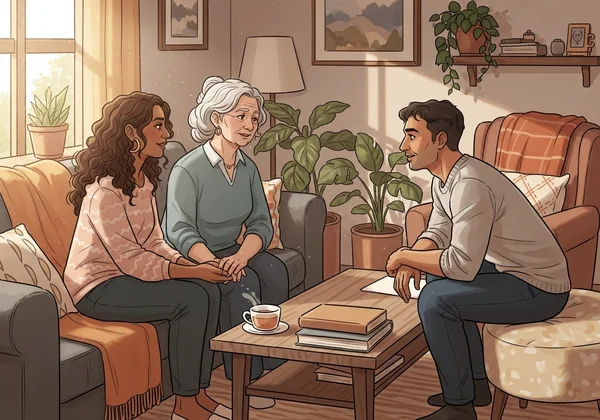Discuss RAADS-R Results: Talk to Doctor & Family
November 11, 2025 | By Elara Vance
You’ve taken the RAADS-R test, and the results are in front of you. For many, this moment brings validation, confusion, and the question, "what now?" "What is the next step after getting RAADS-R score?" Holding this new self-knowledge can feel both empowering yet isolating. Next, you may need to share your results with doctors, therapists, or family. This guide offers practical steps and gentle scripts for discussing autism screening results, so your online reflection turns into real-world support.
If you're just starting, you can explore your traits with our free online screener. Then, use this article to prepare for the talks that may follow.
Prepare to Discuss Your Autism Screening Results
Before you speak with anyone, taking time to prepare. This isn’t not only about a score. Rather, it’s about what the result means to you and how you describe your lived experience. Thoughtful planning builds confidence and supports clear self-advocacy.
Understand What Your RAADS-R Score Means
First, remember what the RAADS-R test is—and is not. The test on our website is a screening tool, not a diagnosis. It highlights traits linked with autism in adults. A high score suggests overlap with common traits; it does not confirm autism. Think of your score as a map that points to areas worth exploring and a language for long-standing feelings or challenges.

Gather Key Information Before Your Conversations
Your own stories are powerful evidence. Therefore, write down specific examples that match the RAADS-R domains: Social Relatedness, Language, Sensory/Motor, and Circumscribed Interests. For example, note if small talk drains you, certain sounds feel painful, or lifelong interests are intense. Later, these notes will help you explain your traits to a doctor or family member.
Practice Your Disclosure: Craft a Clear Message
Decide how you want to share your result. You don't need a script; however, a few key points ready can help reduce anxiety. For instance, you could say, "I've been doing some research to understand myself better, and I took an online screening called the RAADS-R test. The results fit my experiences, and I'd like to talk with you." Practicing this in front of a mirror can help you feel more comfortable and confident.
Talk to Your Doctor or Therapist About Autism
Approaching a clinician is a key step, especially if you are seeking a RAADS-R professional diagnosis. Being prepared helps you feel heard and taken seriously. As a result, the visit can move from vague concerns to a clear plan.

Start the Conversation: Simple Openers
Bringing up autism with a doctor can be intimidating. It's often best to be direct and clear from the start. Book time just for this topic, so you won’t feel rushed. Then try a direct opener:
- "I'm here today because I've been exploring the possibility that I might be autistic. I took the RAADS-R screening online, and saw many traits. I’d like to discuss this with you and ask for a referral for a formal assessment."
- "For a long time, I've struggled with (e.g., social anxiety, sensory overload). I recently discovered the concept of adult autism, and it explains a lot. I brought my screening results and examples to review together."
Handle Questions and Possible Skepticism
Unfortunately, some providers know less about adult autism, especially in women or those who mask. If your doctor seems skeptical, try not to get discouraged. Calmly refer to your written list of lifelong experiences. Use "I" statements, such as "I have always found it difficult to..." instead of "Autistic people do..." This grounds the conversation in your reality. If needed, request a second opinion from a specialist in adult neurodiversity.
Request a Diagnostic Referral and Plan Next Steps
Be clear about the goal: "Could you please provide me with a referral to a specialist for an adult autism evaluation?" Ask how the process works. This might involve waiting lists, so getting the process started is key. Meanwhile, you can review traits with our RAADS-R screening tool to stay organized while you wait.
Talk to Family About Your Autistic Traits
Sharing with family can be deeply personal and emotionally charged. Therefore, choose someone open-minded to start, and pick a calm, private time. Clarify your aim—validation, practical support, or simple understanding. Importantly, your story is yours to tell, on your timeline.

Decide Who to Tell and When
You do not have to tell everyone at once. Start with one trusted person. Choose a time when you are both calm, have privacy, and won't be interrupted. Avoid bringing it up during a heated argument or a stressful family event. Your emotional safety is the top priority. Think about what you hope to achieve by telling them. Is it for validation, to ask for accommodations, or simply to be understood more deeply?
Explain Your RAADS-R Results and Meaning
When you explain your results, connect them back to your life and your shared history. You could say something like, "I always left parties early because loud noise hurts," or "I hyper-focus on topics I love." This shows the label explains long-standing patterns. For deeper context, you can share an AI personalized report that connects scores with lived examples.
Manage Family Reactions
Responses vary. Some family members may be immediately supportive, saying, "That makes so much sense!" Others may be skeptical, confused, or even hurt, perhaps feeling they missed something as a parent. Give them time and space to process. Offer to share resources with them, but don't push. Above all, keep boundaries. Your self-discovery remains valid, regardless of reactions.
Beyond the RAADS-R Score: Empowering Your Journey
Discussing your RAADS-R results is a significant step on a longer journey of self-understanding. Each conversation, whether with a doctor or a loved one, is an act of courage and self-advocacy. Over time, your score becomes a doorway to better self-care, clearer support, and a more honest life.

This path is uniquely yours. Continue to learn, gather your stories, and connect with communities that uplift you. Whether you pursue a formal diagnosis or simply use this knowledge to better support yourself, you are moving toward a more authentic and empowered life. To begin or revisit, start your assessment on our homepage.
Frequently Asked Questions About Discussing RAADS-R Results
Is the RAADS-R test accurate enough to share with my doctor?
Yes, it is. While the RAADS-R is a screening tool and not a diagnostic instrument, it is a scientifically validated measure used in research. Sharing your results with a doctor provides a structured, data-informed starting point for a conversation about your traits and experiences.
Can sharing my RAADS-R results lead to a professional diagnosis?
Sharing your results is an excellent first step, but it does not directly lead to a diagnosis. A professional diagnosis requires a comprehensive evaluation by a qualified clinician, often including interviews, observational assessments, and a review of your developmental history. Your RAADS-R results can be crucial evidence that supports your request for such an evaluation.
How can I best explain my RAADS-R score and its meaning to my family?
The best approach is to personalize it. Instead of just stating the number, explain what it represents in your own life. For example, say, "I scored high in the sensory domain, which explains why I've always been sensitive to loud noises." Using concrete examples from your life makes the information more relatable and understandable for them.
What is the AI personalized report, and should I share it with others?
The AI personalized report is an optional feature on our site that takes your test answers and background information to generate a more detailed, contextual analysis. It can be a very helpful tool to share with a therapist or a trusted family member, as it often articulates insights and connections that you may find difficult to put into words yourself.